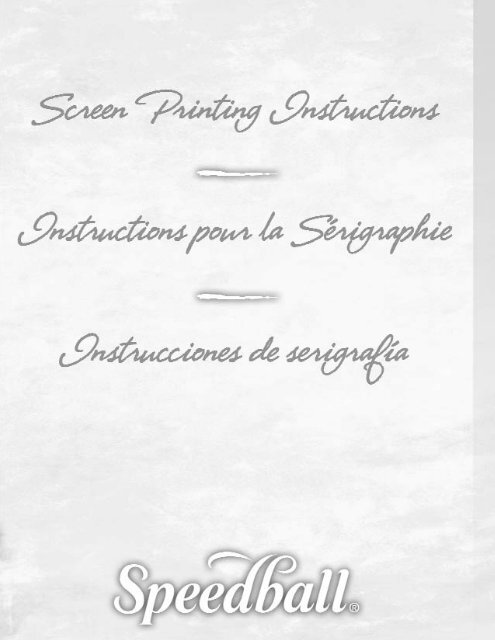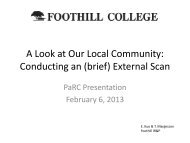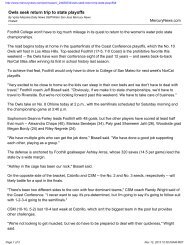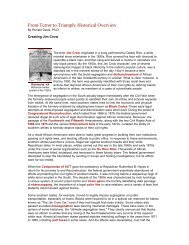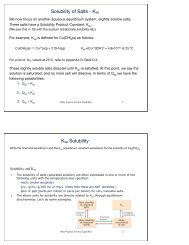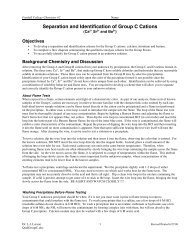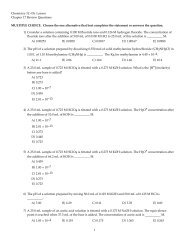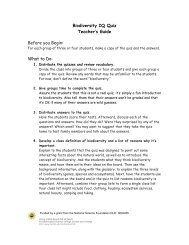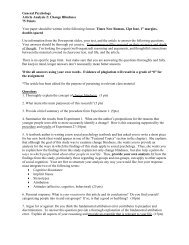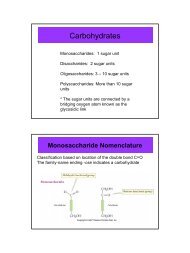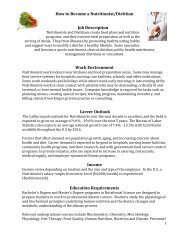Screen Printing Instruction Booklet - Speedball
Screen Printing Instruction Booklet - Speedball
Screen Printing Instruction Booklet - Speedball
You also want an ePaper? Increase the reach of your titles
YUMPU automatically turns print PDFs into web optimized ePapers that Google loves.
PREPARING YOUR WORK AREA<br />
Clear an area for your project. A card table (or similar<br />
space) will provide enough work area. It is necessary to<br />
locate your work area with easy access to a large sink or<br />
laundry tub with hot and cold water.<br />
If you plan to make a large number of prints, you may wish<br />
to set up a “clothesline” that will enable you to hang your<br />
prints with either clothespins or binder clips for drying.<br />
AAddddiittiioonnaall IItteemmss TToo HHaavvee OOnn HHaanndd<br />
• Water resistant masking tape (1” wide)<br />
• Screw driver<br />
• Old newspapers<br />
• Sheet of cardboard<br />
• Small nylon scrub brush<br />
• Scissors<br />
• Small lamp or lamp cord<br />
with a standard socket<br />
BBA No. 1 photoflood or<br />
a clear 150 watt incan<br />
descent bulb.<br />
NOTE: Light bulbs may<br />
be found a most<br />
photo supply stores.<br />
• Reflector shop light<br />
(available at any<br />
hardware store).<br />
You may also use an<br />
aluminum pie pan as<br />
your reflector (cut a<br />
hole large enough for the light socket to fit through, slide<br />
socket through the hole and screw light bulb in place).<br />
• Cellophane tape<br />
• Paper cups<br />
• <strong>Speedball</strong> ® Super Black India Ink<br />
• Old towels, rags, paper towels<br />
• 9” x 12” piece of glass, Plexiglas, or Lucite<br />
• Rubber gloves<br />
• Apron or smock<br />
PREPARING YOUR TOOLS<br />
Step A<br />
Two hinges with screws and removable pins are included in<br />
some <strong>Speedball</strong> ® kits. These are easily attached by first<br />
joining the halves together with hinge pins. It is best to<br />
mount the side of the hinge with two bearings to the base<br />
and the side of the hinge with one bearing to the screen<br />
frame. Then, position the assembled hinges over the “pilot”<br />
holes on top of the frame and base and screw them in<br />
place. Be sure they are right side up. <strong>Speedball</strong> ® offers<br />
heavy duty hinge clamps for bigger screens. Follow this by<br />
screwing the kickleg to the side of the frame. A “pilot” hole<br />
has been provided for this also. Note the kickleg should be<br />
“free-swinging”.<br />
Step B<br />
The next important step in preparation is to detach the<br />
frame from the base and scrub both sides of the screen<br />
fabric with a nylon brush and dishwasher powder/water<br />
solution.<br />
Let it dry thoroughly after rinsing. For water-based inks,<br />
use 1” wide water-resistant masking tape. Lay the tape so<br />
it is divided equally half on the screen fabric, and half on<br />
the screen frame. Turn the frame over and cover the<br />
groove with tape. Be certain that the tape extends beyond<br />
the frame and onto the fabric. For solvent-based inks, use<br />
seal gummed water-soluble tape with several coats of<br />
polyurethane.<br />
2 <strong>Speedball</strong> ® <strong>Screen</strong> <strong>Printing</strong> <strong>Instruction</strong> <strong>Booklet</strong> www.speedballart.com • 1.800.898.7224
Taping in this way helps to maintain a “tight” screen, and<br />
prevents ink from leaking under the screen frame during<br />
printing and will keep the edges of your prints clean. To get<br />
maximum adhesion of the tape, rub it with a spoon. When<br />
choosing your pattern or design make sure to leave a generous<br />
border from the taped edges (minimum of 1” from<br />
taped edge).<br />
Step C<br />
There are a number of ways to prepare a screen to print<br />
your picture or message. While the methods are different,<br />
the basic principle is to make a stencil on the screen fabric<br />
which allows ink to be forced through its “open” areas to<br />
produce a design.<br />
PAPER STENCIL METHOD<br />
PREPARING SCREENS<br />
This is the best method for a beginner. It is the fastest,<br />
least expensive, and simplest way to prepare a screen. The<br />
Paper Stencil Method is good for geometric shapes and<br />
basic patterns. It is not intended for complicated designs or<br />
lettering. Begin by cutting an illustration from paper. Keep<br />
the paper flat and not wrinkled. For more accurate and<br />
durable cut paper stencils, use freezer wrap (shiny side<br />
up). Designs can be cut with scissors or stencil knife or<br />
they can be torn to create a textured appearance.<br />
Step A<br />
Cut your paper stencil. You may wish to create a design by<br />
folding and cutting your paper as illustrated. For your stencil,<br />
you can use either the cutout or the paper remaining.<br />
Step B<br />
Position printing paper under the frame. Lay your cutouts<br />
on this paper as desired and lower the screen.<br />
Step C<br />
Follow the directions found in section “Making Prints”. Press<br />
down on the screen frame to ensure complete contact with<br />
all cutouts. Make your first print. You will find with the first<br />
pass of the squeegee, the ink will cause the cutouts to stick<br />
to the underside of the screen, creating a stencil effect.<br />
Once you see how simple this method is, you may wish to<br />
try variations by creating two or three designs with torn<br />
paper of various shapes and printing each in a different<br />
color or hue. Do not overlap cutout pieces on the screen.<br />
NOTE: Generally ten to fifteen prints can be satisfactorily<br />
produced by this method. When a larger number of prints<br />
are desired, you should use one or more “permanent”<br />
methods.<br />
SCREEN FILLER METHOD<br />
(Direct block-out or “Negative Method”)<br />
Using <strong>Screen</strong> Filler is another simple means of preparing a<br />
screen for printing. The screen filler is used to block out<br />
those areas that you do not wish to print. This allows the<br />
ink to be forced through the screen wherever the <strong>Screen</strong><br />
Filler has not been applied.<br />
Step A<br />
On a sheet of plain paper, make up the illustrations or message<br />
you wish to print with your screen. Place this layout<br />
on a tabletop. Place your screen over this layout and trace<br />
your design directly on the screen fabric using a soft lead<br />
pencil.<br />
Step B<br />
Stir the <strong>Screen</strong> Filler until it is thoroughly mixed to a<br />
smooth consistency. Using a paintbrush, paint the screen<br />
filler on all areas of your layout that you do not want to<br />
print. Be certain that the bottom<br />
of the screen is elevated (not<br />
touching the table). When all<br />
areas to be blocked out are<br />
covered with <strong>Screen</strong> Filler,<br />
flip the screen over and<br />
smooth out places the filler<br />
may have collected on the<br />
opposite side of the<br />
screen. Be careful during<br />
this smoothing out<br />
process not to distort<br />
your work.<br />
Step C<br />
Leave the screen to dry in a level position. Make sure nothing<br />
touches the areas covered with <strong>Screen</strong> Filler. Thorough<br />
drying is necessary. Overnight drying is recommended to<br />
assure best results.<br />
Check for pinholes in the blocked-out areas. You can do this by<br />
holding the screen up to a light. Fill any pinholes with <strong>Screen</strong><br />
Filler and allow to dry completely. You are now ready to print.<br />
NOTE: Since <strong>Screen</strong> Filler is applied to all areas which are<br />
not to be printed, this – along with all traditional “direct”<br />
methods – is considered to be a “negative” method of<br />
printing. Your print will be the opposite of that which you<br />
created in your screen.<br />
www.speedballart.com • 1.800.898.7224 <strong>Speedball</strong> ® <strong>Screen</strong> <strong>Printing</strong> <strong>Instruction</strong> <strong>Booklet</strong> 3
DRAWING FLUID – SCREEN FILLER METHOD<br />
(Tusche – resist or “positive method”)<br />
Step A<br />
On a sheet of plain paper, make up the illustration or message<br />
you wish to print with your screen. Place this layout<br />
on a tabletop. Place your screen over this layout, top side<br />
up. Trace your design directly on the screen fabric with a<br />
soft lead pencil.<br />
Step A (Alternative)<br />
The preparation of a layout is to help guide the application<br />
of Drawing Fluid. If you feel such a guide is unnecessary,<br />
go directly to Step B.<br />
Step B<br />
You can work on either side of the screen. Remember, however,<br />
that your printing will be done from the top (or “inkfill”)<br />
side of the screen.<br />
Be certain that the screen is elevated – not touching the<br />
table. Using a paintbrush, paint the Drawing Fluid over those<br />
areas of your layout that you want to print. Leave the screen<br />
to dry in a level, flat position. Make sure nothing touches the<br />
areas covered with Drawing Fluid.<br />
Step C<br />
After the Drawing Fluid is completely dry, open the <strong>Screen</strong><br />
Filler and mix it thoroughly to a smooth consistency. Spoon it<br />
onto the screen fabric on the same side of the screen used for<br />
the application of Drawing Fluid.<br />
Use the squeegee or the plastic<br />
spreader to apply an evenly<br />
smooth coating over the<br />
entire screen. Make only<br />
one pass. Multiple passes<br />
of <strong>Screen</strong> Filler will dissolve<br />
the Drawing Fluid and prevent character<br />
washout. Again, put the screen to dry in a<br />
horizontal position making sure nothing touches the fabric.<br />
It is important that the <strong>Screen</strong> Filler dries completely.<br />
Step D<br />
When the <strong>Screen</strong> Filler has thoroughly dried, spray cold<br />
water on both sides of the screen. Concentrate the spray<br />
on the areas where Drawing Fluid was applied. These areas<br />
will wash out and the screen will open at the points so that<br />
ink can flow through them. If some areas remain slightly<br />
blocked, scrub them lightly with a small stiff brush on both<br />
sides. (An old toothbrush will work well.) If necessary you<br />
can use Greased Lightning or Washing Soda by Arm &<br />
Hammer dissolved in warm water (1 cup per gallon of<br />
water). DO NOT USE HOT WATER DURING THIS<br />
STAGE. Allow your screen to dry in a level position, bot-<br />
tom-side up. Using a hair dryer or fan may accelerate drying<br />
time. Move to section marked “Making Prints”.<br />
PHOTOGRAPHIC EMULSION METHOD<br />
Use polyester screen fabric. Nylon will stretch with waterbased<br />
inks and is not suitable. Do not use silk or organdy<br />
if you wish to reclaim the screen.<br />
This is one of the most exciting methods of screen printing<br />
because it offers the widest range of possibilities. It makes<br />
possible the printing of fine line drawings, various hand and<br />
commercial lettering techniques, as well as photographic<br />
half-tone positives.<br />
All methods of photographic screen printing require three<br />
things:<br />
1. A screen prepared with a light-sensitive coating<br />
(Photo Emulsion).<br />
2. A film positive, or equal (Your printed transparency or<br />
acetate sheet).<br />
3. A light source that will enable you to transfer the<br />
opaque images on your positive to the light-sensitive<br />
stencil you have prepared.<br />
Step A – Mixing the photo emulsion<br />
Diazo System: Follow the mixing instructions given on<br />
both containers. Store the sensitized emulsion in a cool and<br />
dark place. Shelf life for the sensitized emulsion is 4 weeks<br />
at 90°F, 8 weeks at 70° F, and 4 months when refrigerated.<br />
Step B – Coating the screen<br />
Coat the screen by first pouring<br />
a bead of the<br />
solution on one end<br />
of the bottom side<br />
of the screen. Spread<br />
it evenly and thinly with<br />
the squeegee. Use more<br />
solution where necessary,<br />
spreading evenly with the<br />
squeegee. Repeat this process on the backside of the<br />
screen, working to achieve an even continuous coating on<br />
both sides of the screen fabric. Return any of the excess<br />
solution to your mixing container. Be careful to clear away<br />
any extra drips of solution to obtain proper exposure.<br />
4 <strong>Speedball</strong> ® <strong>Screen</strong> <strong>Printing</strong> <strong>Instruction</strong> <strong>Booklet</strong> www.speedballart.com • 1.800.898.7224
Step C – Drying the coated screen<br />
In an area AWAY FROM LIGHT AND HEAT, set the screen to<br />
dry horizontally, bottom side down. This will provide the<br />
most even, flat “film” on the underside of the screen. It will,<br />
however, require your elevating the four corners of the<br />
underside of the frame during the drying stage with push<br />
pins or other suitable devices. An empty drawer, cupboard,<br />
cabinet, closet, or under a cardboard box will work we allow<br />
the screen to dry thoroughly. If more than 300 prints are to<br />
be run, it is best to apply a second coating of the sensitized<br />
Photo Emulsion to the bottom of the screen after the first<br />
coat is dry. Remember, work for a smooth even THIN coating.<br />
Repeat the process away from heat and light.<br />
Once the sensitized screen is dry, it must remain in a darkened<br />
area until it is ready to be exposed. A fan in the dark<br />
area will greatly speed up the drying of the emulsion on the<br />
screen.<br />
Step D – Preparing a positive<br />
With <strong>Speedball</strong> ® ’s Diazo System, the maximum allowable<br />
time between application of the sensitized emulsion to the<br />
screen and the exposure is four weeks at room temperature,<br />
in a completely dark environment.<br />
A “positive” is any opaque image (usually black), on any<br />
transparent or translucent surface (like acetate). There are<br />
many ways you may choose to prepare them.<br />
An excellent transparent film for this purpose is prepared<br />
acetate (printed directly on the acetate by your printer, or<br />
copying an image onto the acetate via copy machine). The<br />
printed sheets (positives) have copy and illustrations that<br />
may be used to create a picture or message. With the plain<br />
sheets, you may make artwork on your own with<br />
<strong>Speedball</strong> ® ’s Super Black Ink and an artist’s brush, speedball<br />
Drawing Pens or enamel paint pens. Excellent results<br />
can also be obtained by using a dry transfer, or pressure<br />
sensitive letters and symbols. These can be applied directly<br />
onto tracing paper or clear plastic or acetate. The graphics<br />
must be opaque to light (not see-through). Natural<br />
items such as leaves may be used between the glass and<br />
stencil.<br />
Another way of producing positives is through copy<br />
machines that have the capability of reproducing very<br />
opaquely on film or acetate, tracing paper, etc. In order to<br />
satisfactorily produce a positive using a copy machine, the<br />
following conditions must be met:<br />
1. Black & White line work<br />
2. Must be opaque photographic print<br />
3. Must have high contrast.<br />
Using a desktop computer, you can download many copyright-free<br />
images suitable for screen printing from any simple<br />
graphic program. You can print that image directly on<br />
to transparency material (acetate). You can also make<br />
copies on a copier that will accept transparencies.<br />
TIP: To get a bold solid image, try making 2 copies of the<br />
same image on transparencies. Match the designs and tape<br />
together for use as a positive.<br />
Step E – Light source<br />
The BBA No.1 bulb is preferable, particularly for fine graphics<br />
because the exposure time is less. To set up your “light<br />
station” place the screen on top of a piece of black paper<br />
and center it 12 inches directly below a 150W clear incandescent<br />
bulb or a BBA No.1 Photoflood bulb. You can also<br />
us a light table with 20W florescent tubes. Either should be<br />
fitted with a reflector shop light.<br />
Unfiltered black light tubes will cut exposure time considerably.<br />
Maybe as little a 3–5 minutes. You need to test for<br />
accuracy.<br />
The positive can be placed in contact with the coated (dry)<br />
screen by either of the above methods.<br />
Step F<br />
Before you remove the sensitized screen from the dark drying<br />
area, make sure everything you need to print with is on<br />
hand. Set up your exposure lamp as described in Step E.<br />
Copy and illustrations (positives) can be fixed in place with<br />
cellophane tape. Do not let two layers of tracing paper<br />
overlap. A better alternative than taping the positives to<br />
the screen fabric is to lay a piece of clear glass, Lucite, or<br />
Plexiglas on top of them. One of these must be used if thin<br />
lines or lettering less than _ inches tall is to be printed.<br />
Whichever you use, once you are<br />
sure all positives are in place and<br />
flat against the fabric, you are<br />
ready to expose the screen.<br />
www.speedballart.com • 1.800.898.7224 <strong>Speedball</strong> ® <strong>Screen</strong> <strong>Printing</strong> <strong>Instruction</strong> <strong>Booklet</strong> 5
SPEEDBALL ® SCREEN PRINTING SYSTEM<br />
Recommended Exposure Chart<br />
150-Watt Bulb, Clear Incandescent<br />
<strong>Screen</strong> Size 150W Bulb Height Exposure time<br />
8” x 10” 12 inches 45 minutes<br />
10” x 14” 12 inches 45 minutes<br />
12” x 18” 15 inches 1 hr. 14 minutes<br />
16” x 20” 17 inches 1 hr. 32 minutes<br />
18” x 20” 17 inches 1 hr. 32 minutes<br />
BBA No. 1 Photoflood ((225500 WWaatttt))<br />
<strong>Screen</strong> Size Lamp Height Exposure time<br />
8” x 10” 12 inches 10 minutes<br />
10” x 14” 12 inches 10 minutes<br />
12” x 18” 15 inches 16 minutes<br />
16” x 20” 17 inches 20 minutes<br />
18” x 20” 17 inches 20 minutes<br />
PPLLEEAASSEE NNOOTTEE:: This chart has been prepared using an aluminum<br />
foil pie-plate reflector as indicated in our instructions.<br />
More sophisticated light sources, reflectors and<br />
equipment can be used. However, as any variable is<br />
changed, you will have to adjust the exposure times and<br />
distances. This will require experimentation to obtain proper<br />
results.<br />
Step G<br />
Apply a forceful spray of water (body temperature) to both<br />
sides of the screen. DO NOT USE HOT WATER.<br />
Concentrate this spray on the light images on the topside<br />
of the screen. After a few minutes, these areas will become<br />
“open”. Continue spraying until all unwanted emulsion is<br />
gone. Perform final spraying with cold water.<br />
Once you have completely washed the screen, let it dry<br />
thoroughly in a level flat position.<br />
Hold the dry frame to the light and check for pinholes.<br />
These can be covered with <strong>Speedball</strong> ® <strong>Screen</strong> Filler or<br />
pieces of masking tape stuck to the bottom of the screen.<br />
If <strong>Screen</strong> Filler is used, let the screen dry again.<br />
NOTE: Photo Emulsion should not be left in the screen<br />
indefinitely unless a permanent stencil is wanted. It should<br />
be washed out as soon as the run is completed. See Cleanup<br />
<strong>Instruction</strong>s.<br />
MAKING PRINTS<br />
Step A – Preparations<br />
Attach your screen frame to the base by interesting the<br />
hinge pins. For off-contact printing tape a penny or nickel<br />
to each of the four corners on the underside of the screen.<br />
Place a sheet of your printing paper under the screen and<br />
position it as it is to be printed. Allow for margins. When<br />
you are certain that the paper is in the correct position, lift<br />
the screen gently and mark where each edge of the paper<br />
should be placed.<br />
Cut three pieces of cardboard<br />
about 1” x 2” and use<br />
these for registration guides.<br />
Place these next to the lines<br />
you drew on the base so you<br />
can correctly locate each<br />
sheet to be printed.<br />
These guides should<br />
be fastened securely<br />
with tape or rubber cement. Good guides are particularly<br />
important if you intend to print more than one color on any<br />
print.<br />
Step B – Selecting Inks for <strong>Printing</strong> on Paper<br />
Water Soluble Inks<br />
Art prints require porous-surface papers of high quality. We<br />
recommend 100% rag or heavy paper for best results. For<br />
most other printing applications, construction paper, drawing<br />
paper, charcoal paper, pastel paper, most board items<br />
(except railroad board) and cover stock (especially good for<br />
greeting cards) will work well. Ink remains water-soluble<br />
after drying.<br />
6 <strong>Speedball</strong> ® <strong>Screen</strong> <strong>Printing</strong> <strong>Instruction</strong> <strong>Booklet</strong> www.speedballart.com • 1.800.898.7224
Avoid slick coated, high gloss papers or vinyl or plastic<br />
coated papers.<br />
Stir the ink completely until you achieve a “buttery” or<br />
“creamy” consistency. If too thick, add one or two drops of<br />
water or <strong>Speedball</strong> ® Water Soluble Transparent Extender<br />
Base. Mix thoroughly. Colors may be intermixed.<br />
<strong>Speedball</strong> ® Water Soluble Transparent Extender Base may<br />
be used to make the colors more transparent.<br />
PERMANENT ACRYLIC INKS<br />
Fine art prints require smooth matte finish, medium or<br />
heavy weight papers. To overcome buckling caused by<br />
water penetration, after each color run is dry, place a flat<br />
weight on stacked prints. This will cause them to dry flat<br />
and is especially important for good color registration.<br />
These water-based acrylic inks dry water resistant.<br />
To achieve transparency or economy, <strong>Speedball</strong> ® Extender<br />
Base (preferred) or Transparent Base may be added. Never<br />
add more than 10–15% Transparent Base. Do not allow ink<br />
to dry in screen.<br />
For most other printing applications like posters, greeting<br />
cards, book covers, etc., 20# weight and thicker cover<br />
stock paper is recommended. Avoid slick coated, high gloss<br />
papers or vinyl or plastic coated papers.<br />
Stir the ink completely until you achieve a “buttery” or<br />
“creamy” consistency. If too thick, add one or two drops of<br />
water or <strong>Speedball</strong> ® Acrylic Extender Base <strong>Speedball</strong> ®<br />
Acrylic Transparent Base. Mix thoroughly.<br />
Step B – Alternative<br />
Selecting inks for printing on non-paper surfaces.<br />
WATER SOLUBLE INKS – These can be used on wood or<br />
masonite if first coated with an acrylic emulsion base coat<br />
such as <strong>Speedball</strong> ® Gesso. To achieve water-resistance,<br />
use an acrylic, a spray fixative or a solvent-based varnish<br />
as a topcoat.<br />
FABRIC INKS – These can be used on almost any fabric that<br />
can be subjected to a hot iron (275°-375°F). Do not use on<br />
non-porous fabrics such as nylon.<br />
ACRYLIC INKS – These inks can also be used on wood,<br />
masonite and many coated surfaces. Always pre-test<br />
before using.<br />
Step C – <strong>Printing</strong> on Paper<br />
Spoon the ink across the end of the screen nearest to you.<br />
With the screen lifted slightly from the base, apply an even<br />
blanket of ink onto the print area. Be sure to use an easy,<br />
smooth stroke with the squeegee at a slight angle away<br />
from you. This is the flood stroke. Drop the screen onto<br />
your paper. Lift the squeegee over the ridge of the ink and<br />
make the print stroke by pulling towards yourself. Keep the<br />
squeegee at a 45° angle with enough pressure to scrape<br />
the ink from the screen. Lift the screen from the print,<br />
make the flood stroke, set the kick leg, remove the print<br />
and put it to dry on your rack or line. Insert new paper,<br />
release the kick leg and repeat the process.<br />
Sharp clear prints can be produced provided you maintain<br />
an adequate quantity of ink on the screen, and use the<br />
flood stroke but sparingly. For more detailed images avoid<br />
the flood stroke, and maintain adequate and even pressure<br />
on the squeegee during print stroke.<br />
Step D – Clean up<br />
After you have made your prints, remove any remaining ink<br />
in the screen. This ink can be saved if you wish. Detach the<br />
frame from the base (don’t lose the hinge pins). SEE SEC-<br />
TION ON CLEAN-UP.<br />
PRINTING WITH FABRIC INKS<br />
For the most part, screen printing on fabric is the same as<br />
printing on paper. Use only fabrics that can be subjected to<br />
temperatures of at least 275°-375° F. Do not use on nonporous<br />
fabrics such as nylon. Pre-test all fabrics. Fabrics<br />
with sizing must be washed prior to printing. This will<br />
assure proper adhesion of the fabric ink to the fabric.<br />
Five Important Notes:<br />
1. The screen frame is usually detached from the base<br />
and used alone. Usually two (2) people should work on<br />
the printing process – one holding the screen frame<br />
tightly against the fabric, and the other doing the printing.<br />
2. On articles like T-shirts, a piece of foamboard,<br />
cardboard or paper must be put inside each garment to<br />
act as a barrier.<br />
3. To improve the lubricity (slipperiness) of the ink, you<br />
may add the Transparent Base. To slow drying or to<br />
prevent screen clogging, add the Retarder Base<br />
(1-2 tbs. to 8 oz. of ink).<br />
www.speedballart.com • 1.800.898.7224 <strong>Speedball</strong> ® <strong>Screen</strong> <strong>Printing</strong> <strong>Instruction</strong> <strong>Booklet</strong> 7
4. Wash-up of screens and tools must be done<br />
immediately after use. If they are allowed to dry on<br />
your screen or tools, they are difficult or impossible<br />
to remove.<br />
5. After the fabric ink dries on the fabric, set a household<br />
iron at the highest dry heat (no steam) that will not<br />
scorch the fabric and with a cloth or paper between the<br />
iron and printed material, iron on each side for 3–5<br />
minutes. This will make them withstand repeated washings.<br />
IMPORTANT: PRE-TEST SAMPLES PRIOR TO ALL<br />
PRODUCTION RUNS. If inadequate wash fastness occurs,<br />
the print needs to be heat set longer.<br />
MULTI-COLOR PRINTING<br />
Multi-color signs can be achieved easily by making one<br />
screen with the entire message on it. Prepare the screen by<br />
any method you prefer. Once the screen is ready, simply<br />
block the words you do not want to print with your first<br />
color by putting masking tape or paper on the bottom side<br />
of the screen fabric.<br />
After you have made your first run of prints, wash the ink<br />
from the screen and let it dry. Follow this by blocking out<br />
the words you just printed and unblocking words you want<br />
to print with your second run of color. After you have made<br />
this second run, again wash the screen and let it dry.<br />
Continue to repeat this process until you have completed<br />
your multi-color print.<br />
Making multi-color prints of detailed artwork requires the<br />
making of a screen for each color to be printed. These<br />
screens should be prepared before you start to print.<br />
Additional <strong>Speedball</strong> ® frames are available for purchase in<br />
many retail locations. Please check our website<br />
www.speedballart.com for a store near you.<br />
One interesting effect can be made by having a two color<br />
print on overlapping areas. These overlaps can add a third<br />
(darker) value to the print. <strong>Speedball</strong> ® Transparent or<br />
Extender Bases are formulated to enable screen printers to<br />
achieve this.<br />
Registration guides are very important when printing with<br />
more than one color. Details on registration guides are<br />
given in step A on the “Making Prints” section.<br />
SCREEN CLEAN-UP<br />
An organized work area will make clean up easy. Here are<br />
the Recommended procedures:<br />
WATER SOLUBLE INKS<br />
Use warm water and a soft brush. These inks will remain<br />
water-soluble even after thorough drying.<br />
FABRIC and ACRYLIC INKS<br />
Wash IMMEDIATELY after the last print is pulled.<br />
Use warm water and a soft brush.<br />
Should ink dry in the screen, spray with Windex, or a similar<br />
window cleaner. Rub with a lint-free cloth. When ink is<br />
removed, was with a mix of warm water and dishwasher<br />
detergent using a soft brush. Rinse with warm water.<br />
Drawing Fluid<br />
Wash with cool water.<br />
<strong>Screen</strong> Filler<br />
T M<br />
Speed Clean is preferable for removing screen filler.<br />
One (1) cup of Arm & Hammer’s Washing Soda dissolved<br />
in (1) gallon of water is also suitable.<br />
<strong>Instruction</strong>s are:<br />
A. Apply to both sides with a paintbrush. Scrub with a<br />
nylon bristle brush.<br />
B. Apply again to both sides. Let stand in a horizontal position<br />
for three to five minutes.<br />
C. Scrub with a nylon bristle brush while spraying with a<br />
forceful stream of hot water.<br />
8 <strong>Speedball</strong> ® <strong>Screen</strong> <strong>Printing</strong> <strong>Instruction</strong> <strong>Booklet</strong> www.speedballart.com • 1.800.898.7224
Photo Emulsion<br />
PHOTO EMULSION SHOULD BE WASHED OUT OF YOUR<br />
SCREEN AS SOON AS YOUR PRINT RUN IS COMPLETED –<br />
UNLESS YOU WANT A PERMANENT STENCIL.<br />
ADULT SUPERVISION IS RECOMMENDED FOR THIS<br />
PROCEDURE. WEAR RUBBER GLOVES AND SMOCK.<br />
Photo Emulsion Remover Method:<br />
Be certain all the ink has been removed from the screen<br />
fabric. Apply SPEEDBALL Photo Emulsion Remover liberally<br />
to both sides of the stencil using a paintbrush.<br />
Immediately scrub both sides of the stencil with a dry nylon<br />
bristle brush. Again, apply SPEEDBALL Photo Emulsion<br />
Remover liberally to both sides of the stencil. Keep the<br />
screen in a horizontal position for three (3) minutes. Scrub<br />
both sides with the nylon bristle brush and flush with a hard<br />
spray of hot water. Once you have started removing Photo<br />
Emulsion you must not let the screen dry until completely<br />
clean.<br />
TROUBLESHOOTING<br />
Drawing Fluid, <strong>Screen</strong> Filler or Photo Emulsion will<br />
not adhere to screen.<br />
Possible scenarios:<br />
1. <strong>Screen</strong> fabric may be dirty.<br />
2. <strong>Screen</strong> may have been used with solvent-based<br />
materials or the sizing may not have completely<br />
washed out of the screen fabric.<br />
Solution: Scrub with a soft bristle brush and a<br />
dishwasher powder/water solution. Rinse well.<br />
Photo Emulsion will not wash out to create a stencil.<br />
Possible scenarios:<br />
1. Artwork not prepared with a visually or photo<br />
graphically opaque material.<br />
2. Heat, as well as light, will set the photo emulsion.<br />
There must not be any heat build-up (above 150° F) on<br />
the stencil during exposure.<br />
3. More than 12 hours (at 70° F) exposed before the<br />
sensitized screen was exposed.<br />
4. The sensitized screen was exposed to too much<br />
light or heat before exposure to artwork.<br />
5. Overexposure. The instructions list exposure times and<br />
heights for a “disposable foil pie tin” reflector. More<br />
efficient reflectors will require a higher bulb height<br />
and/or less exposure time.<br />
6. Artwork did not make proper contact with screen.<br />
7. Incomplete washout.<br />
Too much Photo Emulsion washed out of screen after<br />
exposure.<br />
Possible scenarios:<br />
1. Improper mixing of emulsion and sensitizer.<br />
2. Underexposure.<br />
3. Tracing paper or film not sufficiently transparent.<br />
4. Washout temperature was too high (should be<br />
lukewarm, or at body temperature).<br />
5. <strong>Screen</strong> not dry before coating.<br />
6. <strong>Screen</strong> not dry before exposure.<br />
Some small details on Photo Emulsion screen did not<br />
wash out completely.<br />
Possible scenarios:<br />
1. See relevant “Possible scenarios” under “Photo<br />
Emulsion will not wash out to create a stencil”.<br />
2. Failure to use a black, non-reflective background<br />
under the screen during exposure.<br />
Solution: Using a more intense light source, such as a BBA<br />
No. 1 Photoflood, will reduce the require exposure time and<br />
resultant light bounce-back. This will improve detail<br />
washout.<br />
Inks drying in screen.<br />
Solutions:<br />
1. Use the flood stroke technique given in the<br />
instructions.<br />
2. Keep squeegees sharpened.<br />
3. For the Acrylic <strong>Screen</strong> Inks and Fabric Inks, mix with<br />
5–10% Retarder Base.<br />
4. Use a couple of humidifiers or vaporizers in the<br />
printing area.<br />
Textile ink prints not opaque enough.<br />
Solutions:<br />
1. Use a coarser screen fabric.<br />
2. Make multiple passes.<br />
3. Use a rounded squeegee.<br />
4. Use a soft base under the fabric to be printed.<br />
5. Use a hair dryer to flush dry the print immediate<br />
after printing and then reprint overtop in exact register.<br />
www.speedballart.com • 1.800.898.7224 <strong>Speedball</strong> ® <strong>Screen</strong> <strong>Printing</strong> <strong>Instruction</strong> <strong>Booklet</strong> 9
Process Cyan/Couleur<br />
Cyan/Color Cian<br />
45650 - 8 oz/240ml Jar/Fiole/Bote<br />
45750 - 32 oz/.95L Jar/Fiole/Bote<br />
Black/Noir/Negro<br />
4560 - 8 oz/240ml Jar/Fiole/Bote<br />
4600 - 32 oz/.95L Jar/Fiole/Bote<br />
White/Blanc/Blanco<br />
4563 - 8 oz/240ml Jar/Fiole/Bote<br />
4603 - 32 oz/.95L Jar/Fiole/Bote<br />
Violet/Violet/Violeta<br />
4550 - 8 oz/240ml Jar/Fiole/Bote<br />
4575 - 32 oz/.95L Jar/Fiole/Bote<br />
Brown/Brun/Marrón<br />
4567 - 8 oz/240ml Jar/Fiole/Bote<br />
4607 - 32 oz/.95L Jar/Fiole/Bote<br />
Fluorescent Hot Pink/Rose<br />
Foncé Fluorescent/Rosa<br />
Fuerte Flourescente<br />
4687 - 8 oz/240ml Jar/Fiole/Bote<br />
4693 - 32 oz/.95L Jar/Fiole/Bote<br />
10<br />
Fluorescent Magenta/Magenta<br />
Fluorescent/Magenta<br />
Fluorescente<br />
4692 - 8 oz/240ml Jar/Fiole/Bote<br />
4697 - 32 oz/.95L Jar/Fiole/Bote<br />
Night Glo Textile Green/Vert<br />
Textile NNiigghhtt GGlloo/Verde<br />
NNiigghhtt GGlloo<br />
47522 - 8 oz/240ml Jar/Fiole/Bote<br />
Process Magenta/<br />
Magenta/Magenta<br />
45651 - 8 oz/240ml Jar/Fiole/Bote<br />
45751 - 32 oz/.95L Jar/Fiole/Bote<br />
Red/Rouge/Rojo<br />
4561 - 8 oz/240ml Jar/Fiole/Bote<br />
4601 - 32 oz/.95L Jar/Fiole/Bote<br />
Green/Vert/Verde<br />
4564 - 8 oz/240ml Jar/Fiole/Bote<br />
4604 - 32 oz/.95L Jar/Fiole/Bote<br />
Peacock Blue/Bleu<br />
Canard/Azul Verdoso<br />
4551 - 8 oz/240ml Jar/Fiole/Bote<br />
4576 - 32 oz/.95L Jar/Fiole/Bote<br />
<strong>Speedball</strong> ® Fabric <strong>Screen</strong> <strong>Printing</strong> Ink<br />
<strong>Speedball</strong> ® Encre pour sérigraphie textile<br />
<strong>Speedball</strong> ® Tinta para impresión sobre tela<br />
– 19 Brilliant Colors<br />
– 19 Couleurs brillantes<br />
– 19 Colores brillantes<br />
– Easy clean-up with water<br />
– Facile à nettoyer avec de l’eau<br />
– Fácil limpieza con agua<br />
– AP Non-Toxic<br />
– AP non toxique<br />
– AP no tóxico<br />
<strong>Speedball</strong> ® Night Glo Phosphorescent Fabric <strong>Screen</strong> <strong>Printing</strong> Ink<br />
Encre phosphorescente <strong>Speedball</strong> ® pour sérigraphie textile<br />
Tinta fosoforescente <strong>Speedball</strong> ® para impresión en tela<br />
– 4 Phosphorescent Colors<br />
– 4 Couleurs phosphorescentes<br />
– 4 Colores fosforescentes<br />
<strong>Speedball</strong> ® Fabric <strong>Screen</strong> <strong>Printing</strong> Starter Set<br />
Kit de départ de sérigraphie textile <strong>Speedball</strong> ® pour débutants<br />
Set de serigrafía textil <strong>Speedball</strong> ® para principiantes<br />
#4504<br />
– 6 Inks – Blue, Red, Yellow, Black, White, Green<br />
– 6 Encres – Bleu, Rouge, Jaune, Noir, Blanc, Vert<br />
– 6 Tintas – Azul, Rojo, Amarillo, Negro, Blanco, Verde<br />
<strong>Speedball</strong> ® Acrylic Extender Base<br />
Base Acrylique d’Extension <strong>Speedball</strong> ®<br />
Base Acrílica de Extensión <strong>Speedball</strong> ®<br />
#46219 (8 oz./240ml) #46419 (32 oz./960ml) #46619 (1 gallon/3.8L)<br />
– Designed to create transparent color<br />
– Dessinée pour créer de la couleur transparente<br />
– Diseñada Para crear el color transparente<br />
<strong>Speedball</strong> ® Fabric & Acrylic Transparent Base<br />
Base transparente pour sérigraphie <strong>Speedball</strong> ®<br />
Base transparente para impression en serigrafía <strong>Speedball</strong> ®<br />
#4552 (8 oz./240ml) #4577 (32 oz./960ml) #4682 (1 gallon/3.8L)<br />
– Designed to create transparent color<br />
– Dessinée pour créer de la couleur transparente<br />
– Diseñada Para crear el color transparente<br />
<strong>Speedball</strong> ® Fabric <strong>Screen</strong> <strong>Printing</strong> Ink Colors<br />
Couleurs d’encres <strong>Speedball</strong> ® pour sérigraphie textile<br />
Colores de tintas <strong>Speedball</strong> ® para impresión en tela<br />
Orange/Orange/Naranja<br />
4569 - 8 oz/240ml Jar/Fiole/Bote<br />
4609 - 32 oz/.95L Jar/Fiole/Bote<br />
Fluorescent Green/Vert<br />
Fluorescent/Verde<br />
Fluorescente<br />
4690 - 8 oz/240ml Jar/Fiole/Bote<br />
4695 - 32 oz/.95L Jar/Fiole/Bote<br />
Night Glo Textile Blue/Bleu<br />
Textile NNiigghhtt GGlloo/Azul<br />
NNiigghhtt GGlloo<br />
47520 - 8 oz/240ml Jar/Fiole/Bote<br />
Night Glo Textile Yellow/<br />
Jaune Textile NNiigghhtt GGlloo/<br />
Amarillo NNiigghhtt GGlloo<br />
47521 - 8 oz/240ml Jar/Fiole/Bote<br />
Process Yellow/Juane/<br />
Amarillo<br />
45652 - 8 oz/240ml Jar/Fiole/Bote<br />
45752 - 32 oz/.95L Jar/Fiole/Bote<br />
Blue/Bleu/Azul<br />
4562 - 8 oz/240ml Jar/Fiole/Bote<br />
4602 - 32 oz/.95L Jar/Fiole/Bote<br />
Yellow/Juane/Amarillo<br />
4565 - 8 oz/240ml Jar/Fiole/Bote<br />
4605 - 32 oz/.95L Jar/Fiole/Bote<br />
Blue Denim/Denim Bleu/Azul<br />
Vaquero<br />
4566 - 8 oz/240ml Jar/Fiole/Bote<br />
4606 - 32 oz/.95L Jar/Fiole/Bote<br />
Burgundy/Bourgogne/<br />
Burdeos<br />
4684 - 8 oz/240ml Jar/Fiole/Bote<br />
4686 - 32 oz/.95L Jar/Fiole/Bote<br />
Fluorescent Orange/ Orange<br />
Fluorescent/Naranja<br />
Flourescente<br />
4691 - 8 oz/240ml Jar/Fiole/Bote<br />
4696 - 32 oz/.95L Jar/Fiole/Bote<br />
Night Glo Textile White/Blanc<br />
Textile NNiigghhtt GGlloo/Blanco<br />
NNiigghhtt GGlloo<br />
47523 - 8 oz/240ml Jar/Fiole/Bote
Black Pearl/Noir<br />
Perle/Negro Perla<br />
4800 - 8 oz/240ml Jar/Fiole/Bote<br />
Pearly White/Blanc Perle/<br />
Blanco Perla<br />
4803 - 8 oz/240ml Jar/Fiole/Bote<br />
Amethyst/Améthyste/<br />
Amatista<br />
4806 - 8 oz/240ml Jar/Fiole/Bote<br />
Black/Noir/Negro<br />
4540 - 8 oz/240ml Jar/Fiole/Bote<br />
4580 - 32 oz/.95L Jar/Fiole/Bote<br />
White/Blanc/Blanco<br />
4543 - 8 oz/240ml Jar/Fiole/Bote<br />
4583 - 32 oz/.95L Jar/Fiole/Bote<br />
Brown/Brun/Marrón<br />
4546 - 8 oz/240ml Jar/Fiole/Bote<br />
4586 - 32 oz/.95L Jar/Fiole/Bote<br />
Sherbet/Sorbet/Sorbete<br />
4809 - 8 oz/240ml Jar/Fiole/Bote<br />
Raspberry/Framboise/<br />
Frambuesa<br />
4801 - 8 oz/240ml Jar/Fiole/Bote<br />
Emerald/Émeraude/<br />
Esmeralda<br />
4804 - 8 oz/240ml Jar/Fiole/Bote<br />
Magenta/Magenta/Magenta<br />
4549 - 8 oz/240ml Jar/Fiole/Bote<br />
4589 - 32 oz/.95L Jar/Fiole/Bote<br />
Red/Rouge/Rojo<br />
4541 - 8 oz/240ml Jar/Fiole/Bote<br />
4581 - 32 oz/.95L Jar/Fiole/Bote<br />
<strong>Speedball</strong> ® Opaque Fabric <strong>Screen</strong> <strong>Printing</strong> Ink<br />
Encre opaque <strong>Speedball</strong> ® pour sérigraphie textile<br />
Tinta opaca <strong>Speedball</strong> ® para Serigrafía en tela<br />
– Ideal for use on dark fabrics, paper or cardboard<br />
– Idéal pour l’usage sur des tissus obscures, papier ou<br />
papier bristol<br />
– Ideal para el uso en tejidos oscuros, papel o papel cartulina<br />
<strong>Speedball</strong> ® Fabric & Acrylic Retarder Base<br />
Base retardante textile et acrylique <strong>Speedball</strong> ®<br />
Base retardante para tejidos y acrílocos <strong>Speedball</strong> ®<br />
#4639<br />
– Slows the drying time of the inks<br />
– Ralentit le temps de séchage des encres<br />
– Retrasa el tiempo de secado de las tintas<br />
<strong>Speedball</strong> ® Water Soluble <strong>Screen</strong> <strong>Printing</strong> Ink<br />
Encre hydrosoluble <strong>Speedball</strong> ® pour sérigraphie textile<br />
Tinta hydrosoluble <strong>Speedball</strong> ® para Serigrafía en tela<br />
– For use on paper, wood and cardboard<br />
– Pour l’usage sur papier, boiset papier bristol<br />
– Para uso en el papel, madera y papel cartulina<br />
<strong>Speedball</strong> ® Water Soluble Transparent Extender Base<br />
Base hydrosoluble d’extension <strong>Speedball</strong> ®<br />
Base hydrosoluble de extensión <strong>Speedball</strong> ®<br />
#4532 (8 oz/240ml) #4572 (32 oz/960ml)<br />
– Designed to create transparent color<br />
– Dessinée pour créer la couleur transparente<br />
– Diseñada para crear el color transparente<br />
<strong>Speedball</strong> ® Opaque Fabric <strong>Screen</strong> <strong>Printing</strong> Starter Set<br />
Kit de sérigraphie pour des tissues opaques <strong>Speedball</strong> ®<br />
pour débutants<br />
Set serigrafía en tejidos opacos <strong>Speedball</strong> ® para principiantes<br />
# 4590<br />
– 6 Opaque inks – Blue Topaz, Raspberry, Citrine, Black Pearl,<br />
Pearly White, Silver<br />
– 6 Encre opaques – Bleu Topaze, Framboise, Citrine, Noir<br />
perle, Blanc perle, Argent<br />
– 6 Tinta opacas – Azul Topacio, Frambuesa, Citrino, Negra<br />
Perla, Blanco Perla, Plata<br />
<strong>Speedball</strong> ® Opaque <strong>Screen</strong> <strong>Printing</strong> Ink Colors<br />
Couleurs d’Encres Opaques <strong>Speedball</strong> ® pour sérigraphie textile<br />
Colores de tintas opacas <strong>Speedball</strong> ® para impresión en tela<br />
Silver/Argent/Plata<br />
4807 - 8 oz/240ml Jar/Fiole/Bote<br />
Blue Topaz/Bleu<br />
Topaze/Azul Topacio<br />
4802 - 8 oz/240ml Jar/Fiole/Bote<br />
<strong>Speedball</strong> ® Water Soluble <strong>Screen</strong> <strong>Printing</strong> Ink Colors<br />
Couleurs d’Encres hydrosolubles <strong>Speedball</strong> ® pour sérigraphie<br />
Colores de Tintas hydrosolubles <strong>Speedball</strong> ® para Serigrafía<br />
Green/Vert/Verde<br />
4544 - 8 oz/240ml Jar/Fiole/Bote<br />
4584 - 32 oz/.95L Jar/Fiole/Bote<br />
Orange/Orange/Naranja<br />
4547 - 8 oz/240ml Jar/Fiole/Bote<br />
4587 - 32 oz/.95L Jar/Fiole/Bote<br />
Blue/Bleu/Azul<br />
4542 - 8 oz/240ml Jar/Fiole/Bote<br />
4582 - 32 oz/.95L Jar/Fiole/Bote<br />
Citrine/Citrine/Citrino<br />
4805 - 8 oz/240ml Jar/Fiole/Bote<br />
Gold/Or/Oro<br />
4808 - 8 oz/240ml Jar/Fiole/Bote<br />
Yellow/Juane/Amarillo<br />
4545 - 8 oz/240ml Jar/Fiole/Bote<br />
4585 - 32 oz/.95L Jar/Fiole/Bote<br />
Violet/Violet/Violeta<br />
4548 - 8 oz/240ml Jar/Fiole/Bote<br />
4588 - 32 oz/.95L Jar/Fiole/Bote<br />
11
Process Cyan/Cyan/Cian<br />
46210 - 8 oz/240ml Jar/Fiole/Frasco<br />
46410 - 32 oz/.95L Jar/Fiole/Frasco<br />
46610 - 1 Gallon/3.8L<br />
White/Blanc/Blanco<br />
4620 - 8 oz/240ml Jar/Fiole/Frasco<br />
4640 - 32 oz/.95L Jar/Fiole/Frasco<br />
4660 - 1 Gallon/3.8L<br />
Orange/Orange/Naranja<br />
4624 - 8 oz/240ml Jar/Fiole/Frasco<br />
4644 - 32 oz/.95L Jar/Fiole/Frasco<br />
4664 - 1 Gallon/3.8L<br />
Dark Red/Rouge foncée/Rojo<br />
oscuro<br />
4627 - 8 oz/240ml Jar/Fiole/Frasco<br />
4647 - 32 oz/.95L Jar/Fiole/Frasco<br />
4667 - 1 Gallon/3.8L<br />
Violet/Violet/Violeta<br />
4630 - 8 oz/240ml Jar/Fiole/Frasco<br />
4650 - 32 oz/.95L Jar/Fiole/Frasco<br />
4670 - 1 Gallon/3.8L<br />
12<br />
Peacock Blue/Bleu Canard/<br />
Azul Verdoso<br />
4633 - 8 oz/240ml Jar/Fiole/Frasco<br />
4653 - 32 oz/.95L Jar/Fiole/Frasco<br />
4673 - 1 Gallon/3.8L<br />
Black/Noir/Negro<br />
4637 - 8 oz/240ml Jar/Fiole/Frasco<br />
4657 - 32 oz/.95L Jar/Fiole/Frasco<br />
4677 - 1 Gallon/3.8L<br />
<strong>Speedball</strong> ® Permanent Acrylic <strong>Screen</strong> <strong>Printing</strong> Ink<br />
Encre acrylique permanente por sérigraphie <strong>Speedball</strong> ®<br />
Tinta acrílica permanente para serigrafía <strong>Speedball</strong> ®<br />
– For use on paper, wood and cardboard<br />
– Pour l’usage sur papier, bois et papier bristol<br />
– Para el uso en papel, madera y papel cartulina<br />
– 19 Brilliant Colors<br />
– 19 Couleurs brillantes<br />
– 19 Colores brillantes<br />
– Easy clean-up with water<br />
– Facile à nettoyer avec de l’eau<br />
– Fácil limpieza con agua<br />
– Jars have inner seal<br />
– Les fioles ont un joint intérieur<br />
– Los frascos tienen sello interno<br />
– AP Non-Toxic<br />
– AP non toxique<br />
– AP no tóxico<br />
Process Magenta/Magenta/<br />
Magenta<br />
46211 - 8 oz/240ml Jar/Fiole/Frasco<br />
46411 - 32 oz/.95L Jar/Fiole/Frasco<br />
46611 - 1 Gallon/3.8L<br />
Primrose Yellow/Jaune<br />
Onagre/Amarillo Onagra<br />
4621 - 8 oz/240ml Jar/Fiole/Frasco<br />
4641 - 32 oz/.95L Jar/Fiole/Frasco<br />
4661 - 1 Gallon/3.8L<br />
Fire Red/Rouge feu/Rojo fuego<br />
4625 - 8 oz/240ml Jar/Fiole/Frasco<br />
4645 - 32 oz/.95L Jar/Fiole/Frasco<br />
4665 - 1 Gallon/3.8L<br />
– Non-flammable<br />
– Non Inflammable<br />
– No Inflamable<br />
<strong>Speedball</strong> ® Acrylic <strong>Screen</strong> <strong>Printing</strong> Starter Set<br />
Kit de sérigraphie à l’acrylique <strong>Speedball</strong> ® pour débutants<br />
Set de serigrafía sobre acrílico <strong>Speedball</strong> ® para principiantes<br />
#4503<br />
<strong>Speedball</strong> ® Gloss Overprint Varnish<br />
Vernis d’impression brillant <strong>Speedball</strong> ®<br />
Barniz de la impresión brillante <strong>Speedball</strong> ®<br />
#46420 (32 oz./960ml) #46620 (1 gallon/3.8L)<br />
– Preserves against scuffing, weathering, and water<br />
– Protège contre les rayures, l’effritement et l’eau<br />
– Protege contra las raspaduras, la acción atmosférica y el agua<br />
– Non-yellowing, acrylic based<br />
– Ne jaunit pas, à base d’acrylique<br />
– No amarillea, a base de acrílico<br />
<strong>Speedball</strong> ® Permanent Acrylic <strong>Screen</strong> <strong>Printing</strong> Ink Colors<br />
Couleurs d’encres acryliques permanentes <strong>Speedball</strong> pour sérigraphie<br />
Colores de tintas acrílicas permanentes <strong>Speedball</strong> para serigrafía<br />
Gold/Or/Oro<br />
4628 - 8 oz/240ml Jar/Fiole/Frasco<br />
4648 - 32 oz/.95L Jar/Fiole/Frasco<br />
4668 - 1 Gallon/3.8L<br />
Ultra Blue/Ultra bleu/<br />
Ultra azul<br />
4631 - 8 oz/240ml Jar/Fiole/Frasco<br />
4651 - 32 oz/.95L Jar/Fiole/Frasco<br />
4671 - 1 Gallon/3.8L<br />
Emerald Green/Vert Émeraude/<br />
Verde Esmeralda<br />
4634 - 8 oz/240ml Jar/Fiole/Frasco<br />
4654 - 32 oz/.95L Jar/Fiole/Frasco<br />
4674 - 1 Gallon/3.8L<br />
Process Yellow/Jaune/Amarillo<br />
46212 - 8 oz/240ml Jar/Fiole/Frasco<br />
46412 - 32 oz/.95L Jar/Fiole/Frasco<br />
46612 - 1 Gallon/3.8L<br />
Medium Yellow/Jaune<br />
moyen/Amarillo medio<br />
4623 - 8 oz/240ml Jar/Fiole/Frasco<br />
4643 - 32 oz/.95L Jar/Fiole/Frasco<br />
4663 - 1 Gallon/3.8L<br />
Medium Red/Rouge moyen/<br />
Rojo medio<br />
4626 - 8 oz/240ml Jar/Fiole/Frasco<br />
4646 - 32 oz/.95L Jar/Fiole/Frasco<br />
4666 - 1 Gallon/3.8L<br />
Silver/Argent/Plata<br />
4629 - 8 oz/240ml Jar/Fiole/Frasco<br />
4669 - 32 oz/.95L Jar/Fiole/Frasco<br />
4689 - 1 Gallon/3.8L<br />
Dark Blue/Bleu foncé/Azul<br />
oscuro<br />
4632 - 8 oz/240ml Jar/Fiole/Frasco<br />
4652 - 32 oz/.95L Jar/Fiole/Frasco<br />
4672 - 1 Gallon/3.8L<br />
Brown/Brun/Marrón<br />
4636 - 8 oz/240ml Jar/Fiole/Frasco<br />
4656 - 32 oz/.95L Jar/Fiole/Frasco<br />
4676 - 1 Gallon/3.8L
<strong>Speedball</strong> ® Drawing Fluid<br />
Fluide de dessin <strong>Speedball</strong> ®<br />
Líquido de dibujo <strong>Speedball</strong> ®<br />
#4531 (8 oz/240ml) #4571 (32 oz/960ml)<br />
– Apply with brush<br />
– Appliquez avec une brosse<br />
– Apliqúese con un cepillo<br />
<strong>Speedball</strong> ® <strong>Screen</strong> Filler<br />
Remplissage d’écran <strong>Speedball</strong> ®<br />
Relleno de pantalla <strong>Speedball</strong> ®<br />
#4530 (8 oz/240ml) #4570 (32 oz/960ml)<br />
– Designed to block out areas not intended to be screen printed<br />
– Utilisé pour préserver les zones qu’on ne veut pas imprimer<br />
– Diseñado para bloquear las áreas que no queremos imprimir<br />
<strong>Speedball</strong> ® <strong>Screen</strong> Frame<br />
Cadre d’écran <strong>Speedball</strong> ®<br />
Tamiz de pantalla <strong>Speedball</strong> ®<br />
#4509 (8” x 10”, 203.2mm x 254mm)<br />
#4506 (10” x 14”, 254mm x 255.6mm)<br />
#4515 (12” x 16”, 304.8mm x 406.4mm)<br />
#4516 (16” x 20”, 406.4 x 508mm)<br />
<strong>Speedball</strong> ® <strong>Screen</strong> Frame Unit with Base<br />
Cadre d’écran <strong>Speedball</strong> avec de la base ®<br />
Tamiz de pantalla <strong>Speedball</strong> ® con base<br />
#4505<br />
<strong>Speedball</strong> ® Hinge Clamps<br />
Charnières de fixation <strong>Speedball</strong> ®<br />
Bisagras abrazaderas <strong>Speedball</strong> ®<br />
#4513<br />
– Cast aluminum, durable and rust resistant<br />
– Moule en aluminium, durable et antirouille<br />
– Molde en aluminio, duradero y antioxidante<br />
<strong>Speedball</strong> ® <strong>Screen</strong> Fabric-Multifilament Polyester<br />
Tissu d’écran <strong>Speedball</strong> ® - polyester de multifilament<br />
Tejido de malla <strong>Speedball</strong> ® - poliester de multifilamento<br />
#4512 Package 6 sheets of 12xx sheets<br />
Fits 10” x 14” frame<br />
Paquet de six feuilles 12xx. Encastré dans<br />
un cadre de 254mm x 255.6mm<br />
Paquete de seis hojas 12xx. Encaja en un<br />
tamiz de 254mm x 255.6mm<br />
#4514 5 yds. x 52” roll of 12xx<br />
4.5m x 1320.8mm rouleau de 12xx<br />
4.5m x 1320.8mm pieza de 12xx<br />
#4698 5 yds. x 42” roll of 8xx<br />
4.5m x 1066.8mm rouleau de 8xx<br />
4.5m x 1066.8mm pieza de 8xx<br />
#4699 5 yds. x 42” roll of 12xx<br />
4.5m x 1066.8mm rouleau de 12xx<br />
4.5m x 1066.8mm pieza de 12xx<br />
#4700 5 yds. x 42” roll of 14xx<br />
4.5m x 1066.8mm rouleau de 14xx<br />
4.5m x 1066.8mm pieza de 14xx<br />
<strong>Speedball</strong> ® <strong>Screen</strong> <strong>Printing</strong> Textbook<br />
Livret de sérigraphie <strong>Speedball</strong> ®<br />
Cuadernillo de serigrafía <strong>Speedball</strong> ®<br />
#4511<br />
<strong>Speedball</strong> ® <strong>Screen</strong> <strong>Printing</strong> Video<br />
Vidéo de sérigraphie <strong>Speedball</strong> ®<br />
Vídeo de sérigraphie <strong>Speedball</strong> ®<br />
#45410<br />
13
14<br />
DIAZO Photo Emulsion Kit<br />
Kit de photo-émulsion DIAZO<br />
Kit de fotoemulsión DIAZO<br />
#4559<br />
DIAZO Photo Emulsion<br />
Foto-émulsion DIAZO<br />
Fotoemulsión DIAZO<br />
#4579 (26.4 oz/792ml bottle)<br />
DIAZO Sensitizer<br />
Sensibilisateur DIAZO<br />
Sensibilizador DIAZO<br />
#4578 (2 oz/60ml bottle) #4557 (8 oz/240ml bottle)<br />
DIAZO Photo Emulsion Remover<br />
Dissolvant por émulsion photo DIAZO<br />
Eliminador de fotoemulsión DIAZO<br />
#4557 (8 oz/240ml bottle)<br />
<strong>Speedball</strong> ® Graphic/Craft Squeegees<br />
Grafique <strong>Speedball</strong> ® /Balai-éponge<br />
Gráfico <strong>Speedball</strong> ® /Enjugador para manualidades<br />
– For use on paper, wood and cardboard<br />
– Pour l’usage sur papier, bois et papier bristol<br />
– Para el uso en papel, madera y papel cartulina<br />
– Urethane blades are firm, impervious to acids, turpentine and<br />
thinners. Suited for high usage applications<br />
– Les lames d’uréthane sont fermes et imperméables aux acides, à la térébenthine<br />
et au diluants. Idonées pour des applications d’ un élevée utilisation.<br />
– Las láminas de uretano son firmes e impermeables a los ácidos, al<br />
aguarrás y a los disolventes. Idónees en aplicaciones de uso frecuente.<br />
– Urethane Blade<br />
# 4480 6” 75 Durometer (15.24cm)<br />
# 4481 8” 75 Durometer (20.32cm)<br />
# 4482 10” 75 Durometer (25.4cm)<br />
# 4483 12” 75 Durometer (30.48cm)<br />
# 4484 14” 75 Durometer (35.56cm)<br />
– Neoprene blades are suited for shorter print runs.<br />
– Les lames de néoprène sont idonées pour des tirages plus courtes<br />
– Les láminas de neopreno son idóneas para tiradas más cortas<br />
– Neoprene Blade<br />
# 4535 8” 70 Durometer (20.32cm)<br />
# 4536 10” 70 Durometer (25.4cm)<br />
# 4537 12” 70 Durometer (30.48cm)<br />
# 4538 14” 70 Durometer (35.56cm)<br />
# 4539 8” 65 Durometer (20.32cm)<br />
# 4508 9” Craft Red Plastic Handle -<br />
70 Durometer (22.86cm) - Neoprene blade<br />
<strong>Speedball</strong> ® Graphic/Craft Squeegees<br />
Tissu <strong>Speedball</strong> ® /Balai-éponge<br />
Tejido <strong>Speedball</strong> ® /Enjugadores para manualidades<br />
– For use with screen printing on fabric<br />
– Pour l’usage en sérographie textile<br />
– Para el uso en serografía sobre tela<br />
– Non-marking blade<br />
– Lame sans marquage<br />
– Lámina sin marcación<br />
– Rounded edge pushes more ink through the screen and reduces<br />
binding when printing on fabric<br />
– Un bord arrondi pousse plus d’encre à travers l’écran et réduit<br />
l’attachement quand on imprime sur tissu<br />
– Un borde redondeado empuja màs tinta a través de la redecilla y<br />
reduce el encolamiento a la hora de imprimir sobre tejido<br />
– Non-marking Blade<br />
# 4490 6” 50 Durometer (15.24cm)<br />
# 4491 8” 50 Durometer (20.32cm)<br />
# 4492 10” 50 Durometer (25.4cm)<br />
# 4493 12” 50 Durometer (30.48cm)<br />
# 4494 14” 50 Durometer (35.56cm)<br />
– Neoprene<br />
# 4534 9” Fabric/Craft Beige Plastic<br />
Handle (22.86cm) - 65 Durometer
Super Value Opaque Fabric <strong>Screen</strong> <strong>Printing</strong> Kit<br />
Kit de bonne qualité pour sérigraphie sur tissus<br />
Kit de buena calidad para sergrafía sobre tela<br />
#4519<br />
– Includes easy to follow instruction booklet.<br />
– Inclue un livret d’instructions facile a comprende<br />
– Incluye un cuadernillo de instrucciones fácil de entender<br />
– Ideal for use on dark colors.<br />
– Idéal pour l’usage sur des couleurs foncées<br />
– Ideal para el uso en colores oscuros<br />
Glo ‘N’ Dark Fabric <strong>Screen</strong> <strong>Printing</strong> Kit<br />
Set Glo ‘N’ Dark pour sérigraphie textile<br />
Set Glo ‘N’ Dark para impresión sobre tela<br />
#4520<br />
– Includes four water soluble phosphorescent inks that glow in the dark<br />
– Inclut quatre encres phosphorescentes hydrosolubles qui<br />
brillent dans l’obscurité<br />
– Incluye cuatro tintas fosforescentes hidrosolubles que brillan<br />
en la obscuridad<br />
The Original <strong>Screen</strong> <strong>Printing</strong> Kit<br />
Le Kit original pour sérigraphie<br />
El Kit original para serigrafia<br />
#4521<br />
– Includes easy to follow instruction booklet<br />
– Inclue un livret d’instructions facile a comprende<br />
– Incluye un cuadernillo de instrucciones fácil de entender<br />
– For use on paper, wood and cardboard<br />
– Pour l’usage sur papier, bois et papier bristol<br />
– Para el uso en papel, madera y papel cartulina<br />
Deluxe Fabric <strong>Screen</strong> <strong>Printing</strong> Kit<br />
Kit luxueux pour sérigraphie<br />
Kit de de lujo para serigrafía<br />
#4522<br />
– For use on paper, wood and cardboard<br />
– Pour l’usage sur papier, bois et papier bristol<br />
– Para el uso en papel, madera y papel cartulina<br />
– Includes easy to follow instruction booklet and video<br />
– Inclue un livret d’instructions facile a comprende et video<br />
– Incluye un cuadernillo de instrucciones fácil de entender y video<br />
Ultimate <strong>Screen</strong> <strong>Printing</strong> Kit<br />
Kit final pour sérigraphie<br />
Kit final de serigrafía<br />
#4523<br />
– Designed for the true screen printing enthusiast!<br />
– Prévu pour le vrai enthousiaste de la sérigraphie!<br />
– ¡Diseñado para el verdadero entusista de la sergrafía!<br />
Fabric <strong>Screen</strong> <strong>Printing</strong> Tool Kit<br />
Kit à outils de sérigraphie textile<br />
Kit de herramientas para impresión sobre tela<br />
#4524<br />
– Includes easy to follow instruction booklet<br />
– Inclue un livret d’instructions facile a comprende<br />
– Incluye un cuadernillo de instrucciones fácil de entender<br />
#4526<br />
Super Value Fabric <strong>Screen</strong> <strong>Printing</strong> Kit<br />
Kit de bonne qualité pour sérigraphie sur tisus<br />
Kit de buena calidad para serigrafía sobre tela<br />
– A terrific basic introduction to fabric screen printing!<br />
– Une introduction de base merveilleuse pour sérigraphie sur tissues<br />
– Una introducción básica fabulosa a la serigrafía sobre tela<br />
– Includes easy to follow instruction booklet<br />
– Inclue un livret d’instructions facile a comprende<br />
– Incluye un cuadernillo de instrucciones fácil de entender<br />
15


